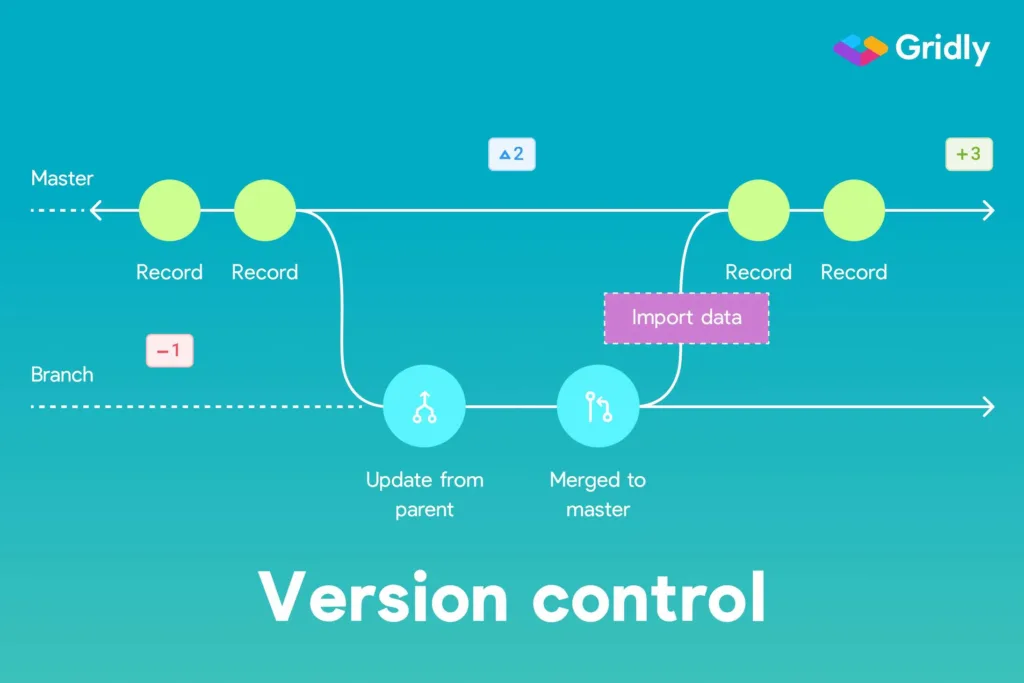Imagine meticulously crafting a document, pouring your heart and soul into each sentence. Days later, disaster strikes: your computer hiccups, and hours of work vanish. A chilling scenario, right? But what if we told you there’s a safeguard, a digital guardian angel called Version Control, that can whisk you back to any stage of your work like a time machine?
Intrigued? Buckle up, because we’re diving deep into the fascinating world of Version Control, unraveling its mysteries and showcasing its power.
At Its Core: What is VersionControl?
Think of Version Control (VC) as a record-keeper for your digital projects. It meticulously tracks every change you make to a file – a document, code, design, or anything digital – over time. Imagine it as a film director capturing every scene, every edit, ensuring you can revisit any moment in the creative process.
So, instead of having just one, linear version of your work, VC creates a branching, interconnected history. With a click, you can rewind to an earlier version, compare different iterations, and even merge changes from collaborators seamlessly.
Why Embrace Version Control?
The benefits of VC are as numerous as the stars on a clear night. Here are just a few:
- Safety Net: Lost work? No problem! Revert to any previous version with ease, safeguarding your efforts from accidental overwrites or technical glitches.
- Collaboration Made Easy: Working with others becomes a breeze. VC allows multiple people to work on the same project simultaneously, merging their changes harmoniously.
- Tracking Progress: See the evolution of your work unfold. VC acts as a visual timeline, showcasing every decision and iteration, aiding in understanding and improvement.
- Improved Workflow: No more emailing multiple versions or untangling conflicting changes. VC streamlines collaboration, boosting productivity and efficiency.
- Peace of Mind: Knowing your work is protected and easily recoverable fosters a sense of calm and confidence, allowing you to experiment and innovate without fear.
Unveiling the Tools: Popular Systems
The magic of VC happens through specialized software called Version Control Systems (VCS). Here are two popular options:
- Git: The reigning champion, Git boasts a powerful command-line interface and robust branching capabilities, making it ideal for developers and tech-savvy users.
- Subversion (SVN): A user-friendly option with a GUI interface, SVN excels in simplicity and centralized control, making it perfect for beginners and collaborative projects.
Beyond these, numerous VCS options cater to specific needs and preferences. Choosing the right one depends on your comfort level, project scope, and team dynamics.
Mastering the Art: Getting Started with Version Control
So, how do you unlock the power of VC? The process is surprisingly simple.
- Choose your VCS: Research and select a system that aligns with your needs and comfort level.
- Set up your repository: This is the central storage for your project’s history. Think of it as a digital library for all your versions.
- Start tracking changes: Use VCS commands or the GUI to record your modifications. Every time you save, a new snapshot is captured.
- Collaborate and explore: Share your repository with others, merge changes, and utilize VC’s features to navigate your project’s history with ease.
Remember, the initial learning curve might seem daunting, but countless online resources and communities are available to guide you. Embrace the journey, and soon, VC will become an indispensable part of your digital workflow.
Beyond the Basics: Advanced Features and Use Cases
While the core principles remain the same, VC offers a spectrum of advanced features for specific needs:
- Branching and Merging: Create separate workspaces to experiment without affecting the main project, then seamlessly merge your improvements back in.
- Conflict Resolution: When multiple users edit the same section, VC helps identify and resolve conflicting changes.
- Version Tags: Mark specific versions as milestones or release points for easy reference and deployment.
- Issue Tracking: Integrate VC with bug tracking tools to streamline development and manage issues effectively.
These features expand VC’s reach beyond code, making it valuable for writers, designers, and anyone working on collaborative digital projects.
The Future of Version Control: Innovation and Expansion
The world of VC is constantly evolving, with new features and integrations emerging to cater to diverse needs. Here are some exciting trends to watch:
- AI-powered assistance: Imagine AI suggesting optimal branching strategies or automatically resolving conflicts – a glimpse into the future of intelligent VC.
- Cloud-based solutions: Seamless integration with cloud platforms ensures accessibility and collaboration from anywhere.
- Focus on user experience: Expect simplified interfaces and intuitive workflows, making VC even more accessible for everyone.
As technology advances, Version Control (VC) will continue to empower individuals and organizations in exciting ways. Let’s explore how:
Democratizing Innovation: With the rise of low-code/no-code development platforms and citizen science initiatives, more people are venturing into creative and technical fields. VC’s intuitive tools will become even more accessible, enabling wider participation in innovation across disciplines. Imagine citizen scientists seamlessly collaborating on research projects, utilizing VC to track data and experiments with ease.
Boosting Open-Source Contributions: Open-source development thrives on collaboration and shared knowledge. Enhanced VC features, like automated conflict resolution and AI-powered code review, will streamline the contribution process, encouraging more individuals to participate and accelerate open-source innovation.
Securing the Future of Data: As data becomes the lifeblood of many industries, robust VC systems will be crucial for ensuring its integrity and security. Imagine blockchain-based VC solutions offering tamper-proof records and enhanced auditability, fostering trust and transparency in data-driven decision-making.
Revolutionizing the Metaverse: With the burgeoning metaverse promising immersive virtual experiences, VC will play a vital role in managing and tracking content creation. Imagine users seamlessly collaborating on 3D objects and virtual environments, utilizing VC to prevent accidental overwrites and maintain version control across diverse digital assets.
Harnessing the Power of AI: Imagine a future where AI algorithms automatically suggest optimal branching strategies, predict potential conflicts, and even generate code based on version history. Such advancements will not only streamline workflows but also unlock new possibilities for AI-assisted creation and problem-solving.
In conclusion, the future of Version Control is brimming with potential. As technology evolves, VC will not just be a tool for managing changes, but an engine for empowering individuals, fostering collaboration, and driving innovation across diverse fields. So, embrace the power of Version Control today, and get ready to be part of a future where digital creation and collaboration reach new heights.
Frequently Asked Questions about Version Control: Unlocking Your Doubts
The world of Version Control (VC) might seem complex at first, but many common questions have simple answers. Let’s shed light on some of the most frequently asked ones:
Is Version Control only for code?
Absolutely not! While popularized in software development, VC’s applications extend far beyond. Writers, designers, musicians, researchers – anyone working on digital projects can benefit from tracking changes and collaborating seamlessly.
Is it difficult to learn Version Control?
The basics are quite simple! Starting with a user-friendly VCS and utilizing online resources can make the initial learning curve smooth. As you gain experience, you can explore advanced features to tailor VC to your specific needs.
Is there a “best” Version Control System?
The ideal VCS depends on your comfort level, project type, and team dynamics. Git offers immense power and flexibility, while Subversion shines in user-friendliness and centralized control. Explore options and choose the one that resonates with you.
What if I make a mistake with Version Control?
Fear not! VC systems are designed with safety nets. You can easily revert to previous versions, undo accidental changes, and even resolve conflicts arising from multiple edits.
Is Version Control worth the effort?
Absolutely! The benefits outweigh the initial learning curve. From safeguarding your work to streamlining collaboration, VC empowers you to work smarter, not harder. Imagine confidently experimenting, knowing you can always rewind, or effortlessly collaborating with teams across the globe – that’s the magic of Version Control.
In conclusion
Version Control is not just a software tool; it’s a philosophy of empowered creation and seamless collaboration. Embrace its potential, and join the growing community harnessing the power of VC to unlock the future of digital work.



